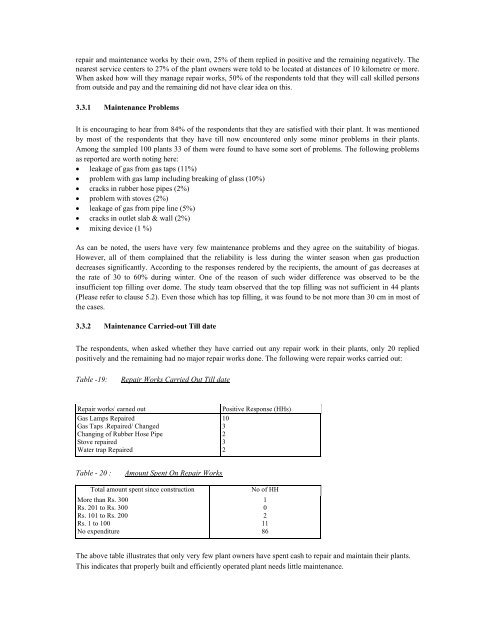download (pdf, 11MB) - SNV
download (pdf, 11MB) - SNV
download (pdf, 11MB) - SNV
You also want an ePaper? Increase the reach of your titles
YUMPU automatically turns print PDFs into web optimized ePapers that Google loves.
epair and maintenance works by their own, 25% of them replied in positive and the remaining negatively. The<br />
nearest service centers to 27% of the plant owners were told to be located at distances of 10 kilometre or more.<br />
When asked how will they manage repair works, 50% of the respondents told that they will call skilled persons<br />
from outside and pay and the remaining did not have clear idea on this.<br />
3.3.1 Maintenance Problems<br />
It is encouraging to hear from 84% of the respondents that they are satisfied with their plant. It was mentioned<br />
by most of the respondents that they have till now encountered only some minor problems in their plants.<br />
Among the sampled 100 plants 33 of them were found to have some sort of problems. The following problems<br />
as reported are worth noting here:<br />
• leakage of gas from gas taps (11%)<br />
• problem with gas lamp including breaking of glass (10%)<br />
• cracks in rubber hose pipes (2%)<br />
• problem with stoves (2%)<br />
• leakage of gas from pipe line (5%)<br />
• cracks in outlet slab & wall (2%)<br />
• mixing device (1 %)<br />
As can be noted, the users have very few maintenance problems and they agree on the suitability of biogas.<br />
However, all of them complained that the reliability is less during the winter season when gas production<br />
decreases significantly. According to the responses rendered by the recipients, the amount of gas decreases at<br />
the rate of 30 to 60% during winter. One of the reason of such wider difference was observed to be the<br />
insufficient top filling over dome. The study team observed that the top filling was not sufficient in 44 plants<br />
(Please refer to clause 5.2). Even those which has top filling, it was found to be not more than 30 cm in most of<br />
the cases.<br />
3.3.2 Maintenance Carried-out Till date<br />
The respondents, when asked whether they have carried out any repair work in their plants, only 20 replied<br />
positively and the remaining had no major repair works done. The following were repair works carried out:<br />
Table -19:<br />
Repair Works Carried Out Till date<br />
Repair works : earned out<br />
Gas Lamps Repaired<br />
Gas Taps .Repaired/ Changed<br />
Changing of Rubber Hose Pipe<br />
Stove repaired<br />
Water trap Repaired<br />
Positive Response (HHs)<br />
10<br />
3<br />
2<br />
3<br />
2<br />
Table - 20 :<br />
Amount Spent On Repair Works<br />
Total amount spent since construction<br />
More than Rs. 300<br />
Rs. 201 to Rs. 300<br />
Rs. 101 to Rs. 200<br />
Rs. 1 to 100<br />
No expenditure<br />
No of HH<br />
1<br />
0<br />
2<br />
11<br />
86<br />
The above table illustrates that only very few plant owners have spent cash to repair and maintain their plants.<br />
This indicates that properly built and efficiently operated plant needs little maintenance.
















